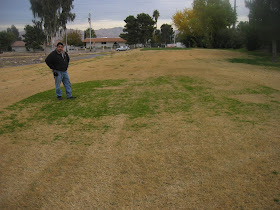Q. So how do we eradicate poa Anna?
 |
| Annual bluegrass in a hybrid bermudagrass home lawn. Notice the discoloration by the Poa when the bermudagrass is actively growing. |
A. Poa annua or annual bluegrass is easy to control in
landscapes but extremely difficult to control in most lawns. If this is in a
lawn such as a cool season grass like tall fescue, Kentucky bluegrass or
perennial ryegrass it is very difficult to control. This is the worst
situation. If it is growing in 100% Bermuda grass it is much easier to control.
If it is growing in a landscape, around trees and shrubs, it is easy to control
with mulch.
Annual bluegrass has evolved.
This grass is very different from what it used to be 50
years ago in many locations. In the old weed control manuals 30, 40 and 50
years ago they all said the same thing. It is a winter annual, the seed
germinating toward the end of summer, flowering or producing seed heads during
the fall and winter months and the seed laying dormant or sleeping through the
summer. It repeats this cycle over and over. Annual bluegrass is a very poor
competitor with mulch but it is an excellent competitor when it grows among
other grasses. When I went to school, this is what I learned annual bluegrass
was.
Annual bluegrass has evolved in certain landscapes and
climates where it now persists as a perennial in warm climates and will produce
seed at different times of the fall and winter months. This is very apparent on
many golf courses and a nightmare for golf course superintendents. This grass
can be mowed very short, 1/4 inch or less, so mowing it out will not happen. It
loves environments where the grass is mowed short and kept wet. It is also very
strong in soil environments that are compacted without much airspace between
soil particles. I would compare it, from an evolutionary standpoint, to the
cockroach.
Controlling it in cool season lawns.
When it grows in cool season lawns, the usual methods of
control are pre-emergent weed killers or herbicides. If this is a home lawn,
you will have an advantage because you can apply these pre-emergent herbicides
several times during the year and that's what you will probably have to do,
starting in late summer and through next spring.
Look at the pre-emergent
herbicides available to you and select one that can be applied to a lawn and
says that it controls annual bluegrass. Make the first application of pre-emergent
herbicide in the middle of late summer. In the hot, southern Nevada climate
this would be about mid July or early August. Read the label and it will tell
you when to make a second application and how much to apply.
 |
| In the past, Scotts has made excellent products for weed control in lawns. |
Pre-emergent
herbicides slowly degrade over time. You want to apply this herbicide a short
time after its peak control period. It will tell you on the label how many
weeks to wait after this first application before the second one is made. There
is some residual from the first application so you will make the second
application at some rate less than the first application. I repeat, the label
will tell you how much to apply and how long to wait before applying the second
application. Continue this cycle of applying, waiting and repeating all winter
long (if the label allows it) and into early spring. That should kill most of
the seed. If you see some young plants that were missed by the herbicide
application (they are usually lighter green and grow faster than the
surrounding grass) then pull them by hand. They will pull out easily because
they have very shallow roots.
 |
| Annual bluegrass biotype producing short rhizomes, adapting like a cockroach to a changing environment. |
 |
| This is a core aerator that punches holes in the lawn. |
months. Aeration helps open the soil which annual bluegrass does not like. As I said before, annual bluegrass likes it wet because it has a very shallow root system. Waiting longer between irrigations helps keep the soil dry and minimizes its invasion.
Preventing annual bluegrass from entering your landscape
and lawn should be done in the future. The seed is transported to the landscape
on shoes that walk across the seed heads during the fall and winter months. If
a landscape has annual bluegrass and people walk across the seed heads and then
walk into your landscape, they will transport the seed and that's where it
starts. It is also transported to lawns in the same way as well as the
lawnmower. If a lawnmower was used on a lawn that had annual bluegrass in it
and it was seeding, I guarantee
100% that this seed will be brought into your lawn if it's the next lawn that is mowed. Mowers should be cleaned thoroughly between lawns to slow the spread of weed seeds such as annual bluegrass and diseases.
100% that this seed will be brought into your lawn if it's the next lawn that is mowed. Mowers should be cleaned thoroughly between lawns to slow the spread of weed seeds such as annual bluegrass and diseases.


No comments:
Post a Comment